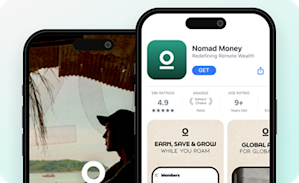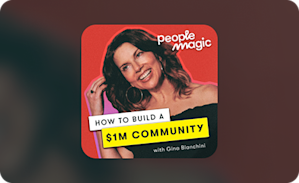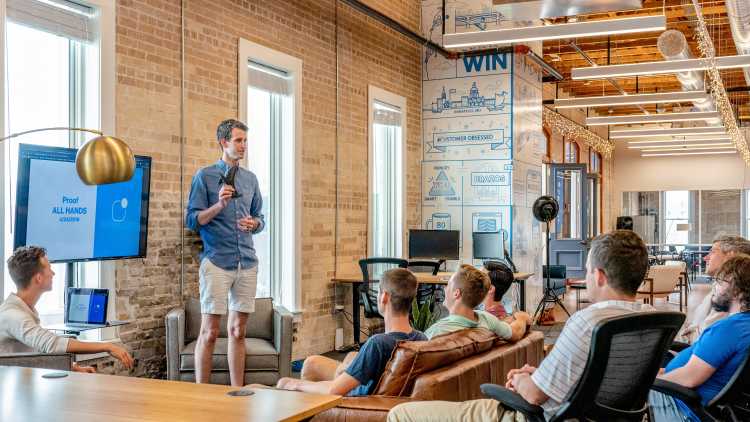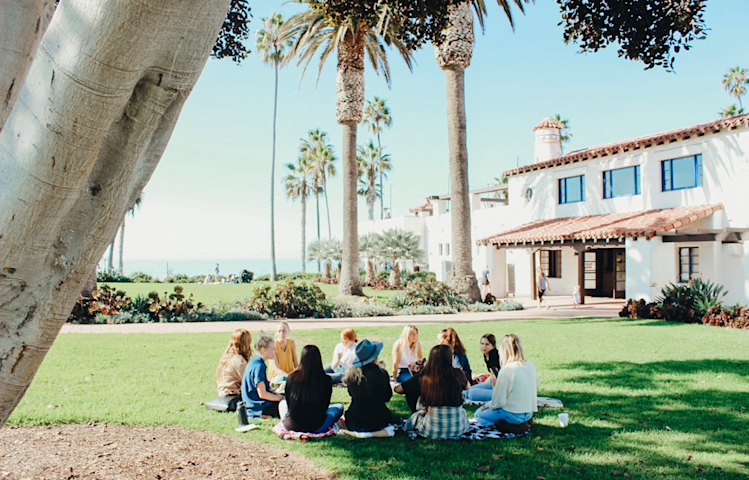Communities & Memberships
Everything You Need to Know About an Online Community (2025)
In this article, we’ll introduce you to the idea of an online community, showing what a community is and isn’t.
Author
Mighty Team
Last Updated
September 2, 2025

The word “community” gets thrown around a lot. But most of the things people call “online community” aren’t really online communities. A TikTok following is not an online community. Neither is your YouTube livestream–no matter how popping the chat is.
In this article, we’ll introduce you to the idea of an online community, showing what a community is and isn’t.
And whether you’re a sole creator with an idea or a business looking to grow a thriving brand community, we’ll show you how the business of community works and why it can change your life.
What is an online community?
An online community is a group of members brought together in an online space by the shared desire to belong. Online communities experience member-led growth, driven by super-members who show up to spend time on what matters to them. Communities tap into our common humanity and benefit from the network effect and user-generated content.
Online communities exist on online community platforms; these are member-first platforms that allow for the full range of human expression and creativity. Basically, the best online community platforms give you a whole set of tools to make rich human connections happen effortlessly and seamlessly.
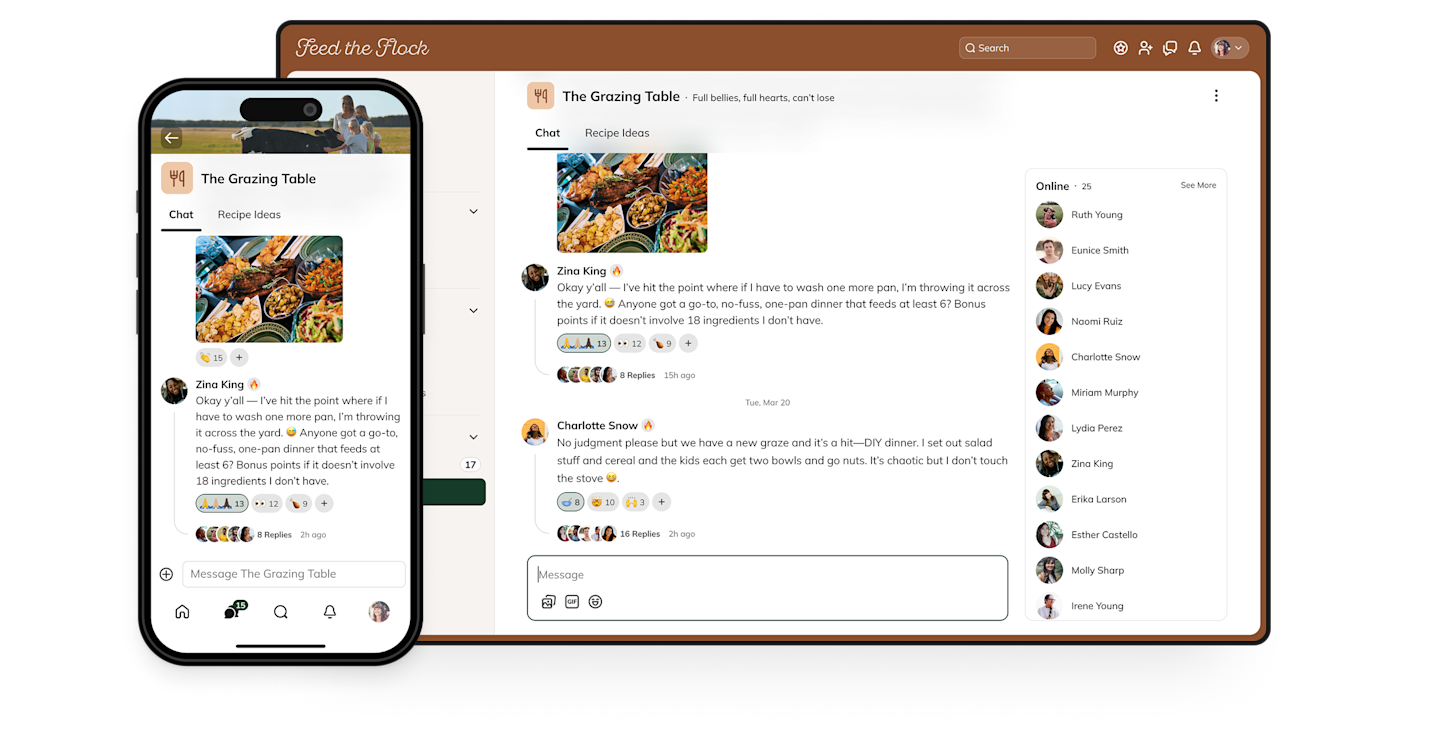
An online community can exist for many different reasons. It could be brought together by a shared interest group, a brand or company (a brand community), a creator, or any leader(s) interested in building a focal point for sharing and transformation.
And of course, an online community can also generate revenue, whether through selling memberships, courses, events, or something else.
Successful Communities Offer Transformation: There’s one final thing most successful communities share. Transformation. The thrivingest communities take their members on a journey of transformation, whether it’s getting a new job, learning to master the Ukelele, or growing your own vegetables.
Case Study: The Slow AF Run Club

Martinus Evans build an Instagram following around being a “Back of the pack” runner (@300poundsandrunning). He turned this passion into a 20,000+ member community–the Slow AF Run Club that helps runners at any level get off the couch.
An online community is…
The word “community” gets thrown around a lot. But in most cases, it’s used as a marketing tool–not to describe a real online community. Contrary to popular belief, your Twitter following is not a community.
Here’s what a real online community needs:
Belonging: Most social media is driven by consumption, not connection. A real online community builds multi-faceted networks and hosts conversations that help members feel like they belong.
Shared purpose: Online communities have some type of shared niche or purpose.
Organic conversations: The heart of an online community is organic, user-generated conversations members join (not just content from a host).
Organization: A community platform should organize your content and so people can find what they need and offer community management tools for Hosts.
Host(s): Online communities have a host or hosts who are community leaders, who help shepherd the community towards a common goal and shape the experience members have.
Unique content: Online communities aren't just regurgitated social media. They host conversations you won't find anywhere else.
Real engagement: Not likes or even surface comments, but conversations that move forward because you’re in them.
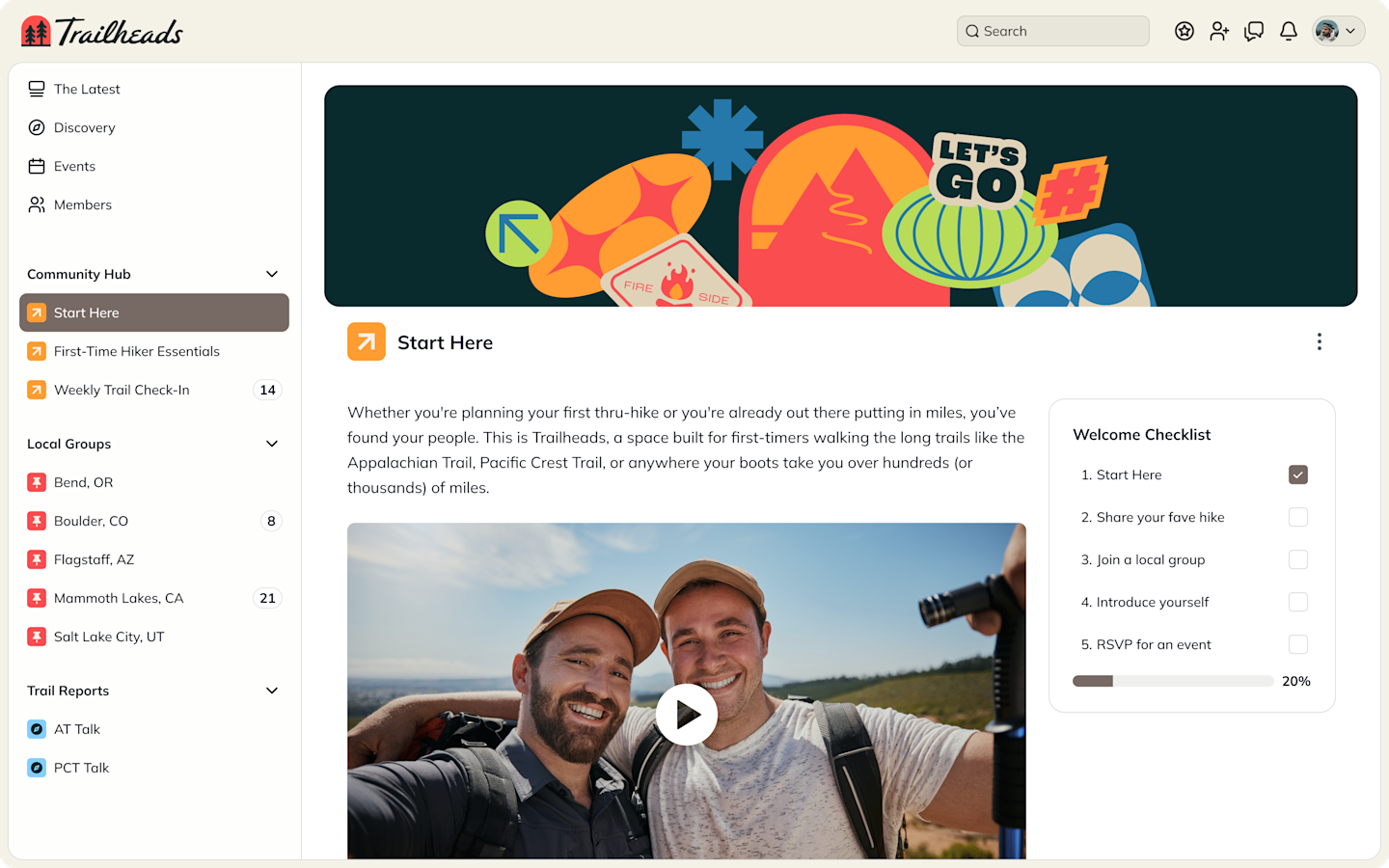
What an online community is not
We mentioned the word “community” gets thrown around a lot. Here are some of the things a community IS NOT – no matter what someone tells you:
A social media following: Influencers might use the word "community, "but if there ain't a network of social connections, it ain't a community.
The voice of one person: Often there's a clear leader(s) that brings the community together, but true community is what happens between members. A community isn’t just member-to-host conversations.
One type of content: Online communities should offer a bunch of ways for users to express themselves.
An addiction: People don’t show up because an algorithm has fed them another dopamine hit. A community is an apple pie, not cocaine.
Anger or negativity: Social media thrives on negative emotions and outrage. Communities are psychologically healthy, safe, and overall positive.
Why build an online community?
An online community is the best way to bring people together to master a topic that’s important or interesting to them. An online community is the single most effective format for members of that community to build new skills, reinforce habits, and achieve results and transformation that would be otherwise difficult to achieve on their own.
For small- to medium-sized businesses, online communities are also the best way for them to learn about what their customers want and are motivated by.
Why brands should build online communities
We’re seeing a huge shift in online business models that are bringing online communities front and center. Brands that are able to build powerhouse, member-led growth businesses create community flywheels that make connection real and selling effortless–McKinsey even identified community flywheels as the business model for the 2020s.
There will only be one kind of successful brand in the future: brands that can transform their customers into members. Brands that don't seize this relationship transformation will die.
The next generation of high-growth companies are going to be the ones that can convert customers, users, and subscribers into members.
It’s a new era of selling and marketing, when you can take people out of the transaction mindset and help them belong.
Case Study: Marie Forleo

Marie Forleo is a #1 New York Times bestselling author and creator of B-School–a program to help ambitious entrepreneurs create businesses and lives they love. She brought B-School together with her other courses–including the Copy Cure and Time Genius–together on one community platform.
Benefits of online communities
Global connections: Online communities aren’t bound by real-world restrictions like geography or timezone—and because of this, there’s often a greater diversity of participants who come together to master something interesting or important together.
Focused conversations: You can connect to people who care about what you do, no matter how niche or unique.
Achieve transformation: The support of an online community also helps empower and inspire members to learn a new skill, build a new habit, or learn a topic they haven’t been able to master on their own. Members also find themselves progressing more quickly and making meaningful, lasting connections along the way.
Combat loneliness: If there’s a loneliness epidemic, finding real connections online can help fight it.
Member-led growth: Online communities experience member-led growth, meaning Hosts can get off the content treadmill and generate a flywheel of user-generated conversations.
Thriving businesses: Online communities become thriving businesses, leading to profitable member-led businesses that make more per-member than any other business model.
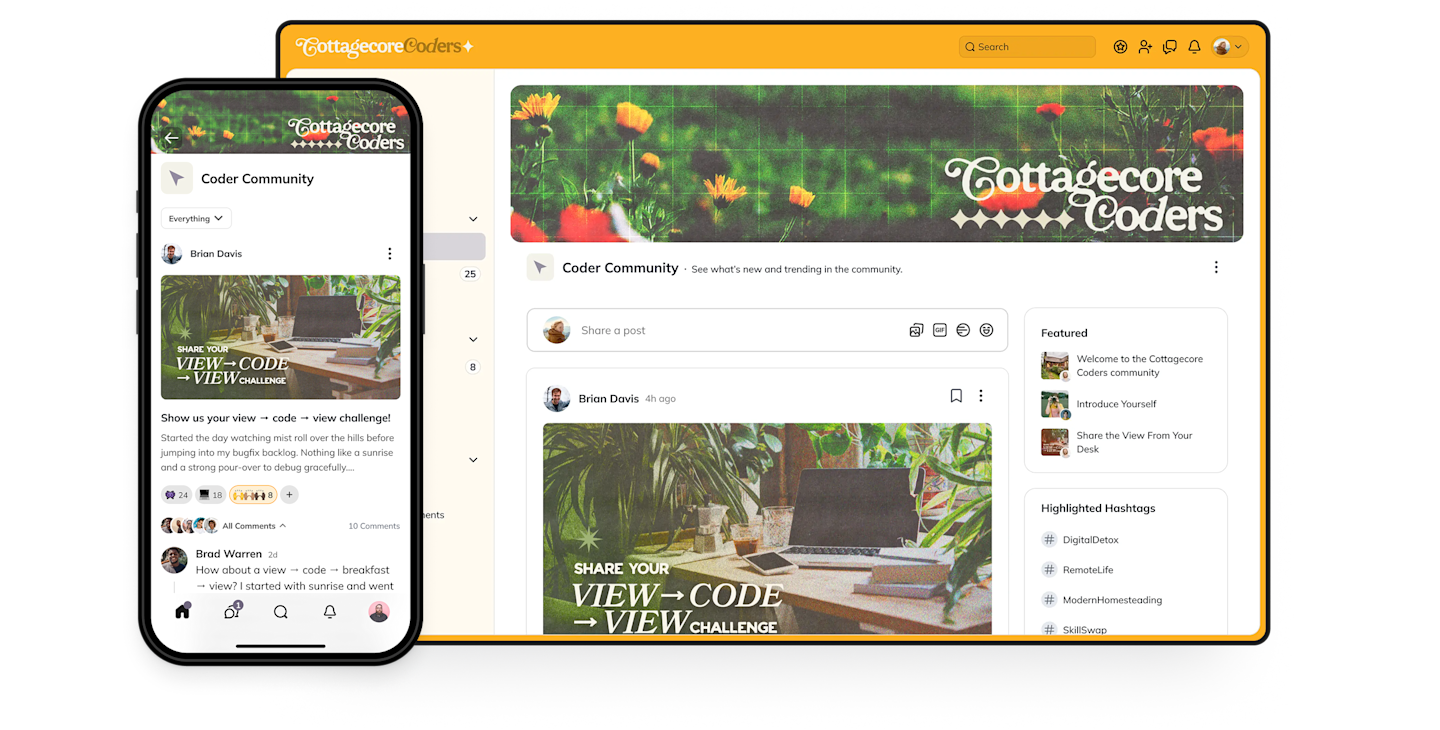
What kills an online community
If you’re building an online community, there are some things that can kill the momentum quickly. Here are the top things to watch out for.
Community Silos: When your community is spread out over different platforms. If you have a course on one platform, a community on the other, and host your events on a third, you’re risking community silos.
Lack of shared focus: Communities should be built around Ideal Members who share a passion for talking about something they care about together.
One-directional leadership: A Host’s job isn’t to throw out endless content and keep the members entertained. A Host needs to bring members into deeper conversation and connection–facilitating instead of directing.
Lack of commitment: An online community is a powerful thing by itself. If you’re going to start a community, go all in. It’s worth it.
Case Study: WealthBuilders

Ashley Fox left a Wall Street career to teach the other 99% how to build wealth. Her community, WealthBuilders, helps members lay a solid financial foundation. Many members are between 35 and 55, earning around $60,000 a year on average. And they learn to grow generational wealth.
What is online community building?
Online community building is how an online community builds relationships, contributions, and sharing between members. An online community is more than its members, it’s also about the space. A community space should be a place that excites members and makes them feel valued.
Roles in an online community
Host(s): The facilitator who brings a community together and helps prompt the conversations that matter.
Moderators: Trusted community members empowered by the host to help maintain order and make sure the environment is positive.
Super-members: The unofficial term for your most dedicated members who are all-in. You can’t have a thriving community without some super-members.
Members: The people who belong to your community, who are along for the transformation.
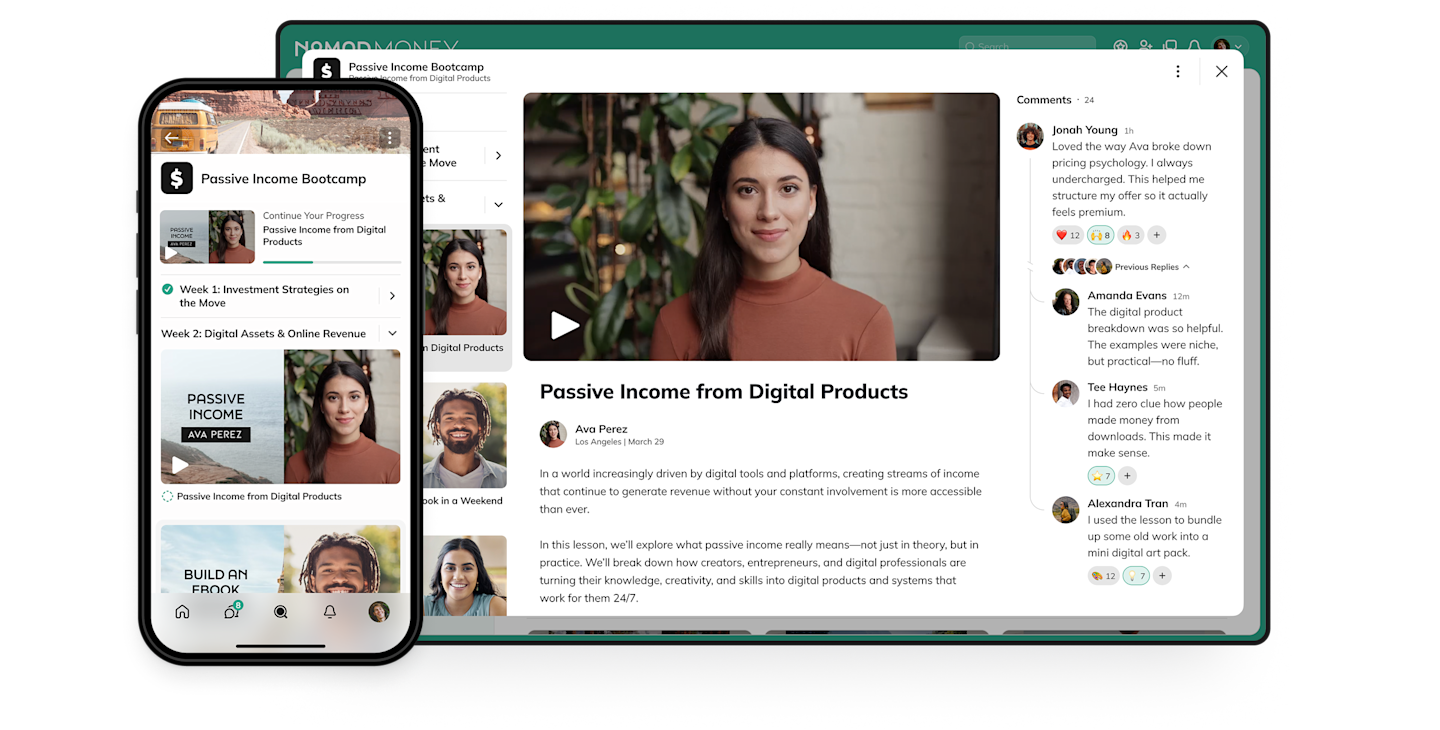
Models of online communities
There are a ton of different models of online communities, but here are some types of online communities that thrive!:
Mastermind Groups: Mastermind members come together to share expert knowledge and transform their businesses or lives.
Group Coaching: Communities hosted by a coach who brings members together for transformation (e.g. fitness coaching).
Micro-Community: Would you believe that even the smallest communities can be powerhouse businesses? It only takes 30 people or less who are dedicated to mastering a special topic, interest, passion, or goal.
Content Community: Members come together to create and/or to learn to create content and share conversations.
Online Brand Community: A true online brand community experiences member-led growth by people who are excited to talk about a brand or product. An example is the Lego community, where people can share ideas and even submit their own builds.
Community of Practice: This model of community is centered around shared practice and professional standards. Think of occupations that benefit from member connection to share ideas and learn from one another.
Event Community: An event community comes together around… you guessed it, an event! There’s something so magical about keeping the energy and connections of an event going year-round.
These aren’t the only kinds of online communities there are, but this should give you an idea.
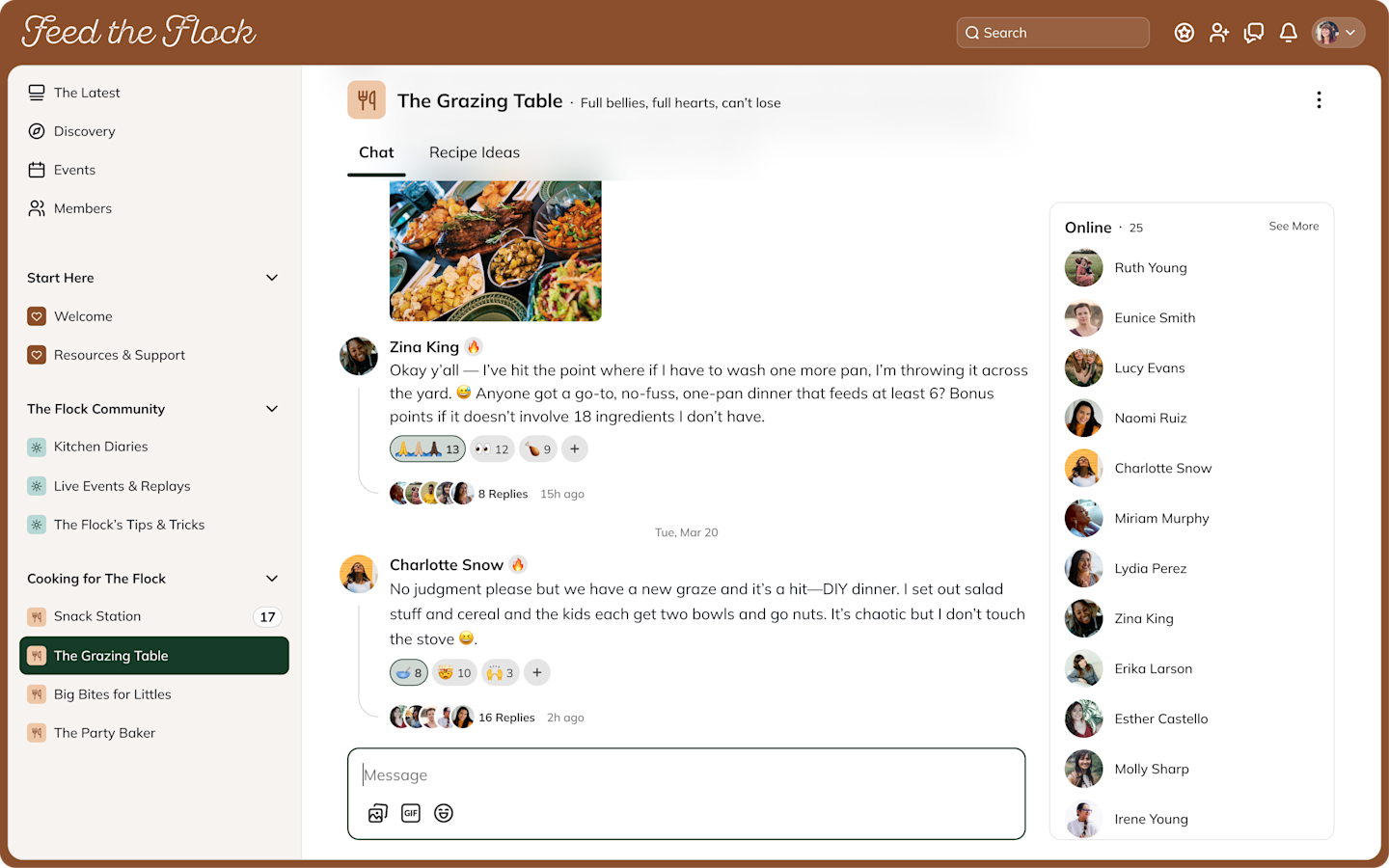
Real online communities making an impact
Boston While Black: One thing that Boston was missing? A safe space for Black students, professionals, and entrepreneurs to come together, activate change, and build relationships. That’s exactly what this paid membership site offers. They offer in-person and virtual programming, by serving members who are seeking access to culturally-relevant experiences, information, and resources to navigate Boston, along with personal and professional connections.
Barista Exchange: This online community platform for baristas has a public forum for baristas to vent and ask for advice. It also offers a classifieds section to buy and sell equipment, a job board, blog posts that act as resources for community members, and specific groups for members to come together and swap tips.
Oiselle Volée. A brand community launched by the women’s apparel brand, Oiselle. It’s 4,000 members strong and runners can connect and share their journeys.
Sadie Robertson Huff is a New York Times bestselling author, speaker, TV star, and influential voice for young Christian women. Sadie runs a faith-based online community and app – LO sister.
History of online communities
To understand how we got to online communities with a ton of features, it's important to understand the history of how they developed. Here are some of the new technologies that led to online communities!
1. Chat rooms
Way back in the '71, a basic chatroom was created by the U.S. government so regional offices could talk in real-time. This led to an online public chat system–especially a system called Talkomatic. A chat room became a way to have conversations with total strangers.
In the 1990s, chat rooms went mainstream as places where you could drop into a room and have group or one-on-one conversations. Chat rooms also created the idea of chatting with people who share common interests–people realized that organic chat worked better when people wanted to talk about the same stuff.
2. Blogs
Early websites gave a way to create pages, and these evolved into content platforms we affectionately refer to as blogs. Weblogs were–well–an open, online diary… early bloggers could share stories about their life and people could read it.
But still, it was content and for many of us the first exposure to user-generated content online.
Blogging platforms meant sharing ideas with text and images. But in 1998, Open Diary developed the radical idea of having comments on a blog.
And poof we had content that people responded to.
Oh yeah. Bloggers were also part of the revolution towards gating content.
AND bloggers also came up with the idea of gated or premium content, which led to monetization.
3. Email Chains
A small but notable blip in the evolution of an online community… remember those email chains? The ones you were supposed to forward to 10 of your friends?
Email made the idea of sending messages at scale mainstream. And it also meant the invention of the newsletter, blasting email subscribers with premium content on a regular basis.
4. Web Forums
Chat rooms evolved into forums. Forums created ways to organize content and conversation, usually with shared interests. The WITproject from the W3 Consortium are credited with the first web forum, building on the idea of a bulletin board.
Unlike a chat room, which thrives on real-time (synchronous) conversations, forums made the conversations asynchronous. It meant you could have a thriving discussion, whether or not people were all there at the same time.
5. Online course platforms
Having gated blog content didn't just mean premium blog posts. It also created a way to monetize education–by having lessons people could pay for.
The first online course was offered by the University of Toronto in 1984. As the tech evolved, the LMS emerged: a teaching platform that could handle multiple lessons and sections.
Later this would mean video courses too.
6. Social networks
SixDegrees is considered the first social network, which let users create profiles and add friends.
This would lead to other social networking platforms like Myspace and Facebook. Different social media platforms experimented with different features. For example, Myspace had an embedded media player that would let you share music. But over time, profiles, posting, and following/connecting became mainstays.
7. Livestreaming
The tech for livestreaming has been around since way back in 1995, when RealNetworks developed a platform to stream a baseball game.
But live streaming wasn't really a thing until YouTube did the first one in 2008. The tech was in place for live streaming, but it took the bandwidth a while to catch up.
Live streaming meant live video, but it also meant live events!
8. All-in-one community platforms & apps
Eventually, an online community platform would take all of these advances and put them in one place: a membership community that could be gated in part or in whole, and where you could host content, courses, community, and commerce–all in one place.
The intersection of social and tech, online community platforms take the human desire for connection and community that drove each of the inventions above, and packed it into a platform that basically let you create any type of content you can imagine.
The modern online community is just tech that enables human connection and creativity, and the very best community platforms get out of the way and let people create and belong.
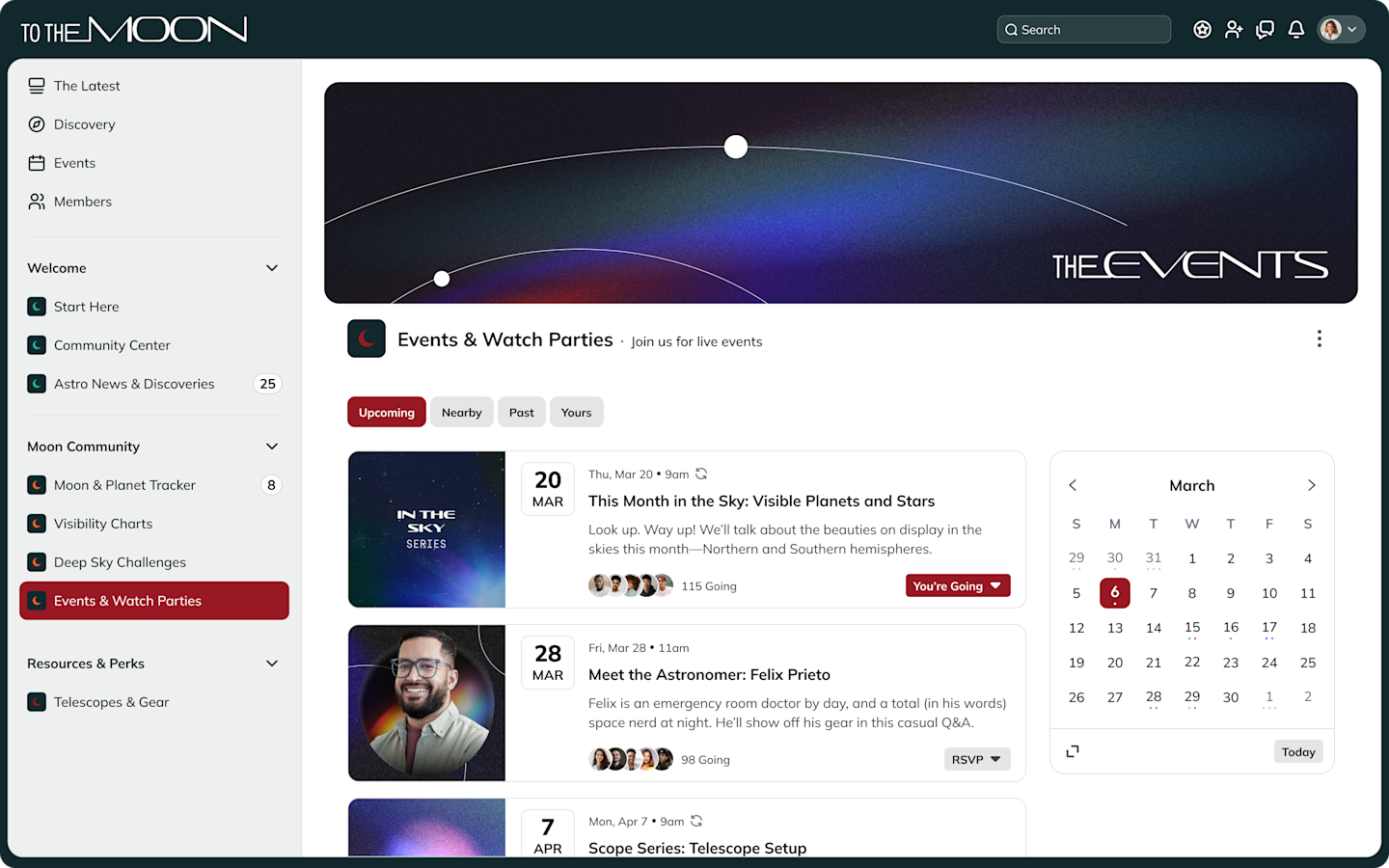
The future of online communities
We don’t have a crystal ball, but here are a few things we’re seeing for the future of online communities.
Thriving businesses will be built around communities: The next generation of high-growth companies are going to be the ones that can convert customers, users, and subscribers into members. The top brands will take people out of the transaction mindset and help them belong to something.
People magic: AI tools like Mighty Co-Host™ will make it radically easier to create thriving communities with a click of a button, sort your members, and start conversations–it’s AI prompting human connection, and it’s magical. We’re already using AI for all these things–you can read about Mighty’s AI features here!
The business of online community
As we talked about at the top, online communities can also be powerful businesses. We’re seeing more and more brands and companies unlocking member-led growth. Here are some of the ways communities interact with commerce:
Memberships: Sometimes communities sell actual memberships. In this instance, the community becomes an awesome business. The average member fee on a Mighty Network is $48/mo ($576 per member/year).
Products: Sometimes online communities support a product or service business. We gave the example of Oiselle Volée; they use their brand community to share running knowledge, help people make new friends and build meaningful relationships, and they even get new product ideas and instant feedback.
Courses: Online learning is still big business, and a lot of communities monetize with e-learning.
Virtual and live events: Communities that are built around a virtual or live event can be a really powerful way to keep the conversation going. And some online communities earn their bread and butter from online events and conferences.
Private groups and high-ticket products: Things like private group coaching and/or masterminds can be a great way to turn a community into a business.
Community is coveted by most brands, multi-million dollar online campaigns are dedicated to the elusive goal of getting engagement–sometimes on social media and sometimes in dedicated brand communities.
The greatest way to turn an online community into a thriving business is to go all in, build on your own platform, and begin the process of converting your subscribers, clients, customers, users, or whatever, into members. All those things are transactional, but members belong.
And ask the Hosts and brands that run online communities, it’s so much easier to launch a product and turn a profit when you have a group of supermembers who are standing by ready to buy your next thing.
Community will transform your business.
FAQs
1. How is an online community different from social media?
The principles are similar. Like social media, online communities work on the network effect and content creation. But here are some ways they’re different:
Many online communities are “closed” requiring joining and/or payment and/or approval. As such, there is more control over membership of an online community and it’s a self-contained ecosystem.
Social media has top-down engagement. A small percentage create content and people react. Online communities have higher engagement rates and more member-to-member connections.
Online communities can easily be monetized through memberships, events, courses, and more. It’s harder to monetize social media. The few platforms that do allow it have a lot of hoops to jump through and creators earn less.
2. Do I need technical skills to create an online community?
Probably not. Most community platforms are easy and intuitive to use. An AI-powered community platform like Mighty Networks is simple to set upand uses AI to streamline community creation and onboarding. The only way you’d need technical skills is if you opt to build your own community platform, or choose a complex tech set-up like WordPress plugins.
3. Is it better for online communities to be free or paid?
There’s no right answer. But we do find that a lot of our paid communities on Mighty have higher engagement. People seem to take a community more seriously when they have some skin in the game. When communities offer transformation, paying a fee often helps the member see the transformation, because they show up and do the work. The average membership fee on Mighty Networks is $48. (Read more about how to price a community here.)
4. What types of content perform best in online communities?
Any content can work! The trick is to figure out what you love to create and what your members love. Some online communities are text-focused discussion boards. Some do videos and virtual meetings. Some run courses. Some meet regularly IRL.
5. How do I start my own online community from scratch?
Here’s a quick breakdown of the steps. But we have a full guide on community building here.
Find your WHY. Find your personal motivation for starting an online community.
Choose Your “Big Purpose”. This is a specific transformation you can offer to one type of person to get them desired results.
Define your Ideal Member, that one specific person who needs that you have to offer.
Plan their Best Year Ever. Identify what needs to be true about that person in one year to achieve the transformation they’re after.
Organize Monthly Themes and a Weekly Calendar. Plug in the activities, training, and experiences your Ideal Member needs to help them live their Best Year Ever.
Choose an online community platform. Ideally it’s an all-in-one platform that’s ready to rock out of the box. We have a breakdown of the best community platforms here.
Share your community. If you have a following or you interviewed your Ideal Members to get to know them, you can share with them.
Start! Even if it’s a small group, get started and let your community grow with you.
6. What platform should I choose for hosting my community?
Come build on Mighty! Mighty Networks is G2’s top-rated community platform. It has all the features you need for a thriving community, and you can get set up in a few minutes. It’s free to try for 14 days - no credit card required.
7. What moderation tools do I need?
Most good community platforms should have some moderation tools built in. On a Mighty Network, members have the option to either block or report other members. Hosts can also assign moderators from their community. Moderators can review reported content or members, get notified when a flag happens, and can remove members who violate community guidelines.
We have a guide to moderation in an online community here.
8. What's the ROI of time invested to launch an online community
With the average member paying $48/mo for online communities on Mighty, the ROI is huge. Add paid events or courses, and many communities earn a lot of recurring revenue. Mighty hosts many communities that earn more than $1 million/year.
You can get some inspiration and real stories in our Case Studies.
9. Can online communities actually lead to meaningful professional relationships?
Of course! Specifically with a clear Ideal Member. Communities thrive when people know why they’re joining and what their goals are. They flounder when they’re missing a clear Big Purpose.
10. How do online communities compare to networking events or conferences?
An online community is an ongoing connection and conversation around something members care about. A networking event or conference is a short term conversation. But the foundations of both are the same. A successful event, like a successful community, needs a clear Ideal Member and Big Purpose.
This is why events and communities go together really well! You can use an event to bring people together around something they care about, and a community to keep the conversation going between your meetings.
Ready to start building your community?
Start a free 14-day trial to explore Mighty—no credit card required.
More like this
Join Mighty Community
Learn the principles of Community Design™ (and see them in action) alongside thousands of creators and entrepreneurs. It's free to join!

Online Courses
Creating a Course
Teaching a Course
Course Platforms
Selling a Course
Communities & Memberships
Community Platforms
Managing a Community
Building a Community
Growing a Community
Monetizing a Community
Content Creation
Creators & Entrepreneurs
Monetization
Content Creation
Starting a Business
Website Builders
Creating & Managing a Website
Events
Event Platforms
Hosting & Marketing Events
Branded Apps
Creating a Mobile App
Coaching Apps
Community Apps
Coaching
Mastermind Groups
Starting a Coaching Business
Coaching Platforms
Filter by Category
Online Courses
Communities & Memberships
Creators & Entrepreneurs
Events
Branded Apps
Coaching
Build a $1 Million Community
This free masterclass went viral—sign up to learn why.


